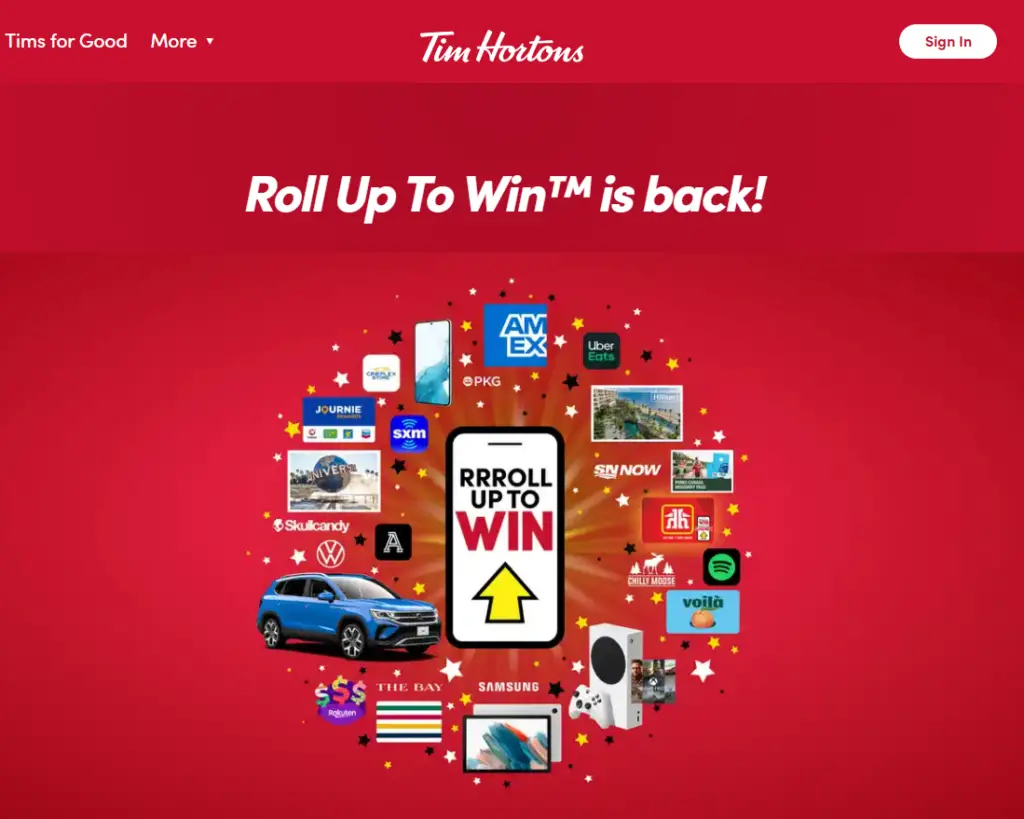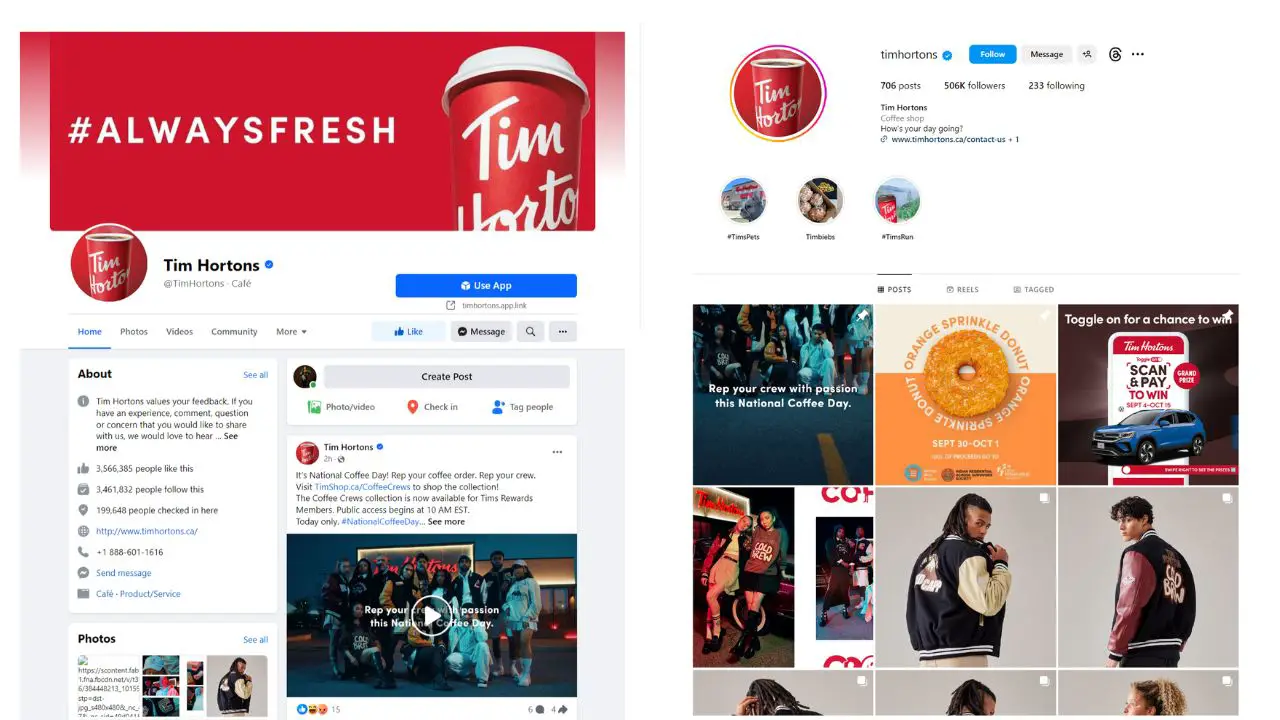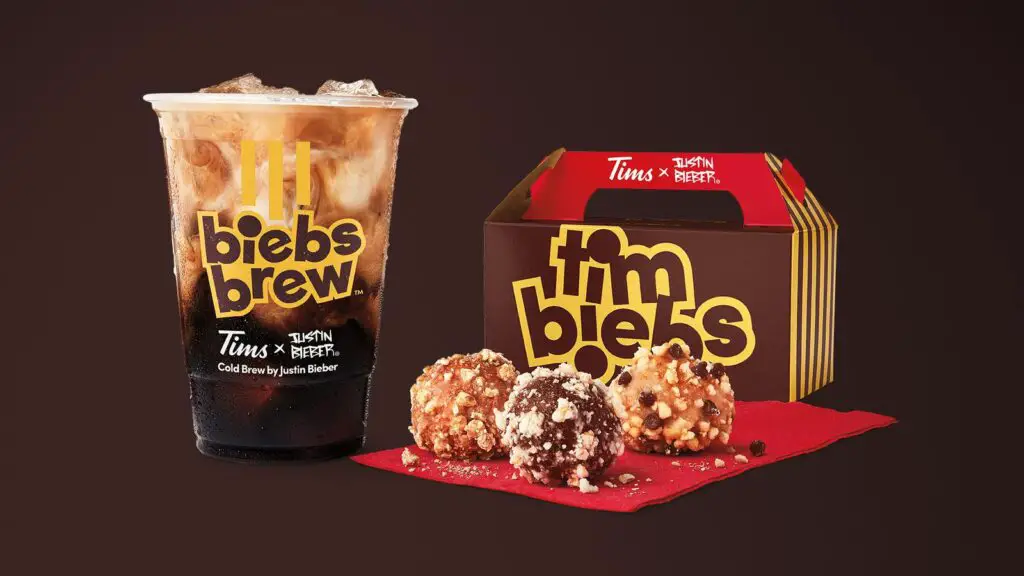In business, marketing plays a very important role in a company’s revenue generation because, without a proper marketing strategy, the company’s efforts wouldn’t be valued enough. Tim Hortons’ marketing strategies have helped to give the brand a competitive advantage in a highly competitive sector of the quick service restaurant segment.
The company, commonly nicknamed Tim’s or Timmie’s is an extremely recognizable brand name in Canada and has strongly been integrated into Canadian culture. It currently has about 5,352 restaurants globally as of June 20, 2022, with 99% brand recognition. The brand has a dominating market position and competes with brands like Subway, McDonalds, Dunkin’ Donuts, and Starbucks.

Due to Tim Hortons’ marketing strategies, the company has been able to grow from the donut store it was in 1964 to become a Canadian multinational coffeehouse and restaurant chain with a market capitalization of $13.09 billion.
The main objective of this article is to discuss the marketing strategy of Tim Horton that has made it stay ahead of the competition.
Read about: Lululemon Marketing Strategies and Marketing Mix
Briefly about Tim Hortons
The brand, Tim Hortons, was founded by Tim Horton, a well-known Canadian hockey player, who played in the National Hockey League (from 1949 till his death in 1974). In 1964, the business opened its first donut store in Hamilton, Ontario under the name Tim Horton Donuts which was later abbreviated to “Tim Horton’s”. Nonetheless, the brand is now known as “Tim Hortons” (without the possessive apostrophe).
Because the founder was a well-known hockey player in Canada, the brand is so closely associated with all things hockey and Canada. Nevertheless, upon his death in 1974, Ron Joyce bought out the Horton family’s shares and took over as the sole owner of the existing chain of 40 stores.
Over the years, Joyce expanded the chain in both geography and product selection. The business created several iconic food favorites, such as the Timbit (launched in 1976) and the Iced Capp (launched in 1999). The business that started as a small coffee and donut shop now offers a wide variety of food products and even sells merchandise such as Christmas ornaments, t-shirts, mugs, hats, etc.
The company has continued to expand and grow locations throughout Canada, North America, and other countries around the world. As of 2018, it had shops located in 14 different countries and currently, has about 5,352 Tim Hortons restaurants across the globe, as of 2022.
Thanks to Tim Hortons’ marketing strategies, brand name, and history, it has been able to position its brand as a leader in the Quick Service Restaurant (QSR) industry. This brand is known for serving high-quality fresh products, at reasonable prices. Also, through its extreme dedication to corporate social responsibility, the company has been able to build a reputation for itself, not only as an industry leader but also as a community leader in the communities it operates in.
See also: Subway Positioning and Marketing Strategies
What is Tim Hortons’ marketing strategy?
Tim Hortons uses a promotion strategy that focuses on increasing brand loyalty, and repeat purchases. The central theme behind its promotion strategy is its differentiating aspects; the company portrays itself as a brand that offers high-quality products, at reasonable prices. This is evident in the company’s tagline “Always Fresh”.
The company implements a marketing strategy that focuses on advertising specific products and combinations, as well as offering free products at the next purchase. Also, with the integrated use of highly visible community caring programs, print, radio, television, online advertising, Tim Card, and event sponsorship, the company is able to build its brand image and market its offerings effectively.
Check out: Demographic Marketing Definition and Importance
Tim Hortons’ marketing strategies
- Segmentation, Targeting, and Positioning (STP marketing)
- Effective use of marketing campaigns
- Digital and Social media marketing
- Endorsement and Influencer marketing
- Content marketing
Listed above are the different strategies used by Tim’s to gain a competitive advantage over its competitors. In this session, we will be discussing each Tim Hortons marketing strategy listed:
Segmentation, Targeting, and Positioning (STP marketing)
Tim Hortons uses an STP marketing tool (Segmentation, targeting, and positioning). This is a consumer-centric approach that helps to deliver more relevant, personalized messages to target audiences. This is one core marketing strategy of Tim Hortons that helps the company target its marketing messages and serve its customer base better.
Segmentation
The market segmentation of Tim Hortons has always been one of its strongest success factors. The company markets and tailors its product to appeal to different segmentations (demographic, psychographic, geographic, behavioral, etc.). This makes it possible for its product to resonate with a desired segment of customers.
Tim Hortons customer demographics
Demographic segmentation sorts a target market by elements like age, gender, occupation, family size, household income, marital status, race, and nationality.
The demographic in terms of age that Tim Hortons has targeted in its marketing strategy has been the adult population that ranges above the age of 25. This population tends to benefit from the restaurant chain being open 24 hours.
Most people over the age of 25 are true coffee lovers and appreciate a coffeehouse that is open anytime they need to have their caffeine fix. Hence, in order to appeal to this demographic, one major Tim Hortons marketing strategy has been to have its locations open 24/7, providing its guests with the opportunity to get coffee, drinks, food, and more, during the day and night time.
Also, other Tim Hortons customer demographics (occupation), include students, business people, and working adults. The company’s restaurants are located near college and university campuses, making it very convenient for students.
Tim Hortons’ marketing strategy towards students has been making its products inexpensive for students, and offering WIFI in its locations so that students or working adults can visit its restaurant and get their homework or work done while grabbing a cup of coffee or lunch.
The company targets business people and working adults because they usually grab their snacks or coffee on their way to their workplace. Hence, the company positions itself as a quick service brand that is conveniently located in many locations.
Psychographic segment
Psychographic segmentation considers the psychological aspects of consumer behavior by dividing markets according to product usage, lifestyle, values, personality traits, opinions, and interests of consumers.
Tim Hortons uses psychographic segmentation and sorts its customers into categories of people who value fast service, fresh coffee, and food items and prefer the company for their everyday cup of coffee or meal on the go.
The company caters to customers who live a fast-paced lifestyle and go to Tim’s for their everyday coffee. Since coffee is the brand’s main product, its goal is to get customers to fall in love with its coffee and remain loyal to the brand. Hence, Tim Hortons’ marketing strategy has been focused on reaching people’s hearts because when customers love a brand, they patronize it.
In order to retain customers who are faithful coffee drinkers, Tim Hortons continuously spices up its breakfast menus to reach that clientele. This has worked for the company in many ways, letting it remain a strong competitor in the fast food market.
Geographic segmentation
This involves dividing the target market by geographic area, such as region, country, or city. Tim Hortons’ marketing strategy is tailored towards about 14 countries with more than 5000 outlets around the world, though mainly in Canada and the USA.
The company markets its brand as a commodity that meets the target audience internationally according to the regional needs of the consumers.
For instance, the Tim Hortons restaurant that originated in Hamilton, Ontario has all Timbits flavors while the one in Thailand does not have many Timbits flavors. This is because donuts and Timbits are a huge deal in Canada, while China doesn’t seem to love them as much.
Targeting
Targeting in marketing involves grouping the target audience into segments in order to design marketing activities that will reach the segments and drive sales.
What is Tim Hortons’ target market?
Tim Hortons’ target market includes people from the lower and middle classes, working adults, business people, families, and students. The company targets this group of people because it has quick service and is conveniently located in many locations.
By grouping its target audience into segments, the company is able to design marketing activities that will appeal to its target audience in order to prompt them to identify with the brand and make purchases. For instance, Tim Hortons’ marketing strategy towards families with young children includes sponsored sports teams, skate days, free community swims, and camp days for children.
Positioning
Tin Hortons’ positioning is about showing its target audience how it wants to be perceived in the minds of customers, in order to differentiate it from competitors like McDonald’s, Starbucks, Dunkin’ Donuts, etc. The company has been able to position itself in the minds of customers as a brand that offers superior quality products and services for its customers and communities.
The brand uses a value-based positioning strategy to build a lasting brand image in the minds of consumers by emphasizing its values like in its tagline “Always Fresh” which has been a consistent part of the brand identity.
The company has positioned itself as a community-based brand that focuses on family, sports, and friendships, providing superior quality products and services through leadership, innovation, and partnerships.
This Tim Hortons marketing strategy has helped to determine the defining characteristic of the company in the consumer’s mind which influences customer perception and drives sales.
Effective use of marketing campaigns
One of Tim Hortons’ marketing strategies is its effective use of marketing campaigns. The company uses solid marketing campaigns to market its products and strategically targets them toward a desired segment of customers.
Over the years, Tim’s has been able to raise the necessary budget to successfully implement several promotional activities like the famous “Roll Up The Rim”. These marketing campaigns have been successful in promoting customer loyalty and encouraging repeat purchases. This has significantly helped Tim Hortons’ branding and capability to implement new products.
Popular marketing campaigns that give Tim Hortons a competitive advantage
- Roll up the Rim campaign
- Smile cookie campaign
- Holiday cup campaign
Here are some of the marketing campaigns used by Tim Hortons to gain a competitive advantage over its competitors:
Roll up the Rim campaign

Roll-up-the-Rim is one of the company’s biggest expenditures and successful marketing strategies. It is an iconic Tim Hortons marketing strategy that began in 1985 and has gone unaltered for years until 2020 when the pandemic happened.
Tim’s makes around 285,000,000 cups, distributed evenly through all Canadian provinces and territories, and other countries, for a duration of weeks wherein customers are supposed to roll the rim of their coffee after they have finished it to see what prize they have won.
This campaign has helped the company gain a lot of sales. It takes place annually, almost every February, and prizes like vehicles, TVs, gadgets, and vehicles are given to the customers who win. Some of the prizes available in this campaign require repeat purchases, such as a free coffee, or donut upon the next order.
Amid the emergence of a global pandemic, the Roll up the Rim campaign went digital. For instance, for 2023, Tim Horton’s 2023 Roll Up To Win™ format was digital; customers were supposed to download the new Tims App and scan for Tims Rewards Play.
There were cars, cash, and millions of coffee and food prizes to be won. Also, for every roll, whether a customer wins or not, he or she earned an entry for a chance to win a daily jackpot of $10,000 in American Express® prepaid cards.
This Tim Hortons marketing strategy has worked for the brand and has no doubt driven sales over the years. One way this campaign benefits the brand is that it encourages purchases from both loyal and nonloyal Tim’s coffee drinkers. For instance, as soon as the promotion starts, a lot of people are seen in a long drive-thru line hoping to be one of the first lucky Roll Up the Rim winners.
At this point, even customers who get their morning cup from Starbucks or from the coffee machine at their office would consider getting their morning cup of coffee from Tim’s because they believe they stand a chance of winning something.
This is to Tim Hortons’ advantage because, after about two or three days of picking up a morning cup from Tim’s, still hopeful of winning something, these new customers soon began to realize how great the brand’s coffee is. They also get to realize and try other products on the menu like tea, lattes, hot chocolate, etc.
The most important thing about this Tim Hortons marketing campaign is that the customers remember that the brand gave them the opportunity to be rewarded for their patronage. Not only does this campaign offer a special bonus to loyal customers who would be buying a cup of coffee regardless, but it also provides an enticement for non-brand loyal people.
Smile cookie campaign

The Smile cookie campaign is another Tim Hortons marketing strategy that promotes the brand’s rating and boosts its customer base. For over 25 years, the company has been spreading smiles along with guests around North America. When a customer buys a cookie, 100% of the purchases are given to support charities and community groups.
This campaign has been successful over the years and has been one of the campaigns that has helped reinforce Tim Hortons’ branding. This year (2023), the company partnered with Penny Oleksiak, a champion Canadian swimmer, in support of Smile Cookie Week.
By supporting charities and community groups across Canada with the proceeds from the sale of every Smile cookie, the company is able to position itself and build a lasting brand image in the minds of customers as a community-based brand that offers superior quality products and services.
Last year, the restaurants across Canada raised a record-breaking $15 million for over 600 local charities and community groups. This was indeed an incredible accomplishment contributing to the Smile Cookie legacy of over $90 million raised since the program started.
Holiday cup campaign
The Holiday Cup campaign is one of Tim Hortons’ marketing strategies. Every year, the company releases holiday cups during the holidays with a unique marketing strategy. For instance, in 2014, Tim’s launched its holiday cups which feature festive sweater designs and were accompanied by a social media campaign.
The company had launched a hashtag #WarmWishes where the company encouraged Canadians to post their good deeds on Twitter or Instagram along with their holiday cup. Every time someone shares a good deed using the #WarmWishes hashtag, the company donates a toque to a child in need through the Tim Hortons Children’s Foundation.
The goal of this Tim Hortons’ marketing strategy was to provide up to 10,000 kids with a toque. This campaign was successful and helped to reinforce the brand’s positioning and image.
Digital and social media marketing

Using the internet and other forms of digital communication to promote its brand and connect with potential customers is another prominent Tim Hortons marketing strategy. Digital marketing has been very beneficial to the brand as it enables the company to reach a wider audience informing them about its product offerings and sharing content that brings about engagement and patronage.
The company is active on social media platforms like Facebook, Linked In, Instagram, and Instagram. Tim’s is followed on Facebook and Instagram with more than 3M followers and 506K followers respectively (as of 2023). The content the brand posts on its social media is usually fun and entertaining which causes engagement along with branding its products and new launches.
Endorsement and influencer marketing

Tim Hortons uses influencer marketing as one of its marketing strategies. This involves enrolling influencers and celebrities who have established credibility to discuss or mention the brand on social media.
One of Tim Hortons’ successful influencer marketing strategies in 2021 was its collaboration with Justin Bieber, a famous singer, to launch three new Timbit flavors called Timbiebs. Hope Bagozzi, the company’s chief marketing officer, had stated that Timbiebs was a huge success and was truly beyond all of their expectations.
Six months after Timbiebs, the company teamed up with Bieber again and co-created his own French Vanilla-flavored Cold Brew coffee called Biebs Brew.
This particular celebrity endorsement was a departure from the brand’s usual lineup of professional hockey players and helped attract a different demographic. According to Bagozzi, the collaboration opened the brand to a different audience and a different conversation beyond just hockey. He also stated that Justin has wide appeal, but definitely does appeal to younger guests.
In conclusion, this collaboration was beneficial to the brand because Justin Bieber has a huge fan following across the world and this resulted in Tim Hortons products being promoted on a global level. Thus, causing a huge profit for the company.
Content marketing
As the world is going digitally, Tim Hortons is also evolving and growing its brand through digital marketing. The company creates and shares relevant videos, articles, podcasts, and other media to attract, engage, and retain an audience.
Tim Hortons uses a people-first social strategy that reflects its values as its core content marketing strategy. It creates and shares meaningful content focused on the people who love the brand.
The company’s advertisements are known for their heart-warming content about family, Canadian identity, and perseverance. This reinforces Tim Hortons’ branding, associating it with all things Canada.
You can watch on youtube one of the most well-known and iconic Tim’s commercials called “Proud Fathers” as an example to show how the company uses its marketing strategy to sell the Canadian Identity to its audience.
In the commercial, the brand is not directly trying to sell us anything because we see Tim Hortons Coffee being featured as a subtle piece of the story in the background.
The aim of this commercial is to sell us a feeling. As seen, there is a special heartwarming moment between father and son when the son realizes his dad (who seemed to be unsupportive of his hockey-playing) was actually there at all his games.
However, when we have a deeper insight, we’ll see the ways Tim Hortons was connected to this story:
- When the father snuck in to see his son play hockey, he was given Tim’s coffee by another dad and told “You belong here too.”
- Later, and over the years, the father shares Tim’s coffee with his son, as if he is passing along this “tradition.”
- Also, the father specifically says “double-double”, a well-known Canadian way of saying ‘two shots of cream and two shots of sugar‘.
This commercial is a typical example of how Tim Hortons’ marketing strategy tries to sell us a feeling rather than a product. The coffee is not, at least the focal point of the commercial, instead, the feeling of belonging, familial bonds, Canadian identity, and tradition are the main themes in the commercial. However, this still sells the perception that Tim’s coffee is associated with these feelings.
Therefore, despite the video having little relation to coffee, the content showcases Tim Hortons’ people-first mentality and underscores a powerful message of inclusion. Thus, telling us that the brand sees the people it serves, as just as much, a part of its business as the products it sells.
Last Updated on November 2, 2023 by Nansel Nanzip BongdapObotu has 2+years of professional experience in the business and finance sector. Her expertise lies in marketing, economics, finance, biology, and literature. She enjoys writing in these fields to educate and share her wealth of knowledge and experience.
